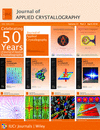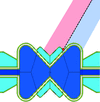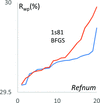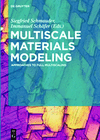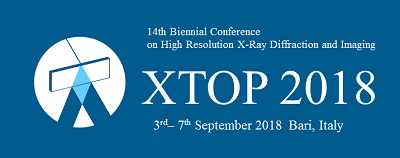issue contents
April 2018 issue

Cover illustration: To mark the journal's 50th anniversary, we revisit some classic covers from the past 50 years - and look forward to the future. For details of cover images see the 1995, 1997, 2002, 2010, 2012, 2013, February 2015, August 2016 and June 2017 issues. Preview of the June 2018 cover courtesy of Wood et al. [J. Appl. Cryst. (2018), 51, 294-314].
editorial
Free 

The Editors of Journal of Applied Crystallography mark the journal's 50th anniversary.
research papers
The implementation is described of neutron diffraction from aligned lipid bilayer stacks on the Wide-Angle Neutron Diffractometer (WAND), located at the High Flux Isotope Reactor, Oak Ridge, Tennessee, USA.
The suite of small-angle neutron scattering instrumentation available at the High Flux Isotope Reactor and Spallation Neutron Source of Oak Ridge National Laboratory is presented.
The article describes recent upgrades of the polarized neutron reflectometer D17 at the Institut Laue–Langevin, Grenoble, France, and presents recent examples of scientific studies enabled with the new options.
A new technique is described, exploiting a focusing prism to measure the wavelength of cold neutrons. The technique can be applied to neutron reflectivity, resulting in considerable gains in performance.
Open  access
access
 access
accessAll instruments at the European Spallation Source (ESS), Lund, Sweden, are served by a carefully optimized moderator assembly, providing world-leading performance and excellent flexibility and upgradeability.
This paper describes the conceptual design of a new direct-geometry inelastic spectrometer, called CHESS, which is planned for the Second Target Station at the Spallation Neutron Source in Oak Ridge, USA.
The design, performance, operation and scientific highlights from the QUOKKA SANS instrument at the OPAL Research Reactor, Australia, are described.
Open  access
access
 access
accessWith implementation of the cross-correlation technique at the short-pulse Spallation Neutron Source (SNS), Oak Ridge, Tennessee, USA, CORELLI obtains both the total scattering and the elastic-only scattering simultaneously from a single measurement with an unprecedented data collection rate.
Open  access
access
 access
accessA new detection system based on an array of 3He tubes and innovative fast detection electronics has been installed on the small-angle neutron scattering (SANS) diffractometer KWS-2 at the Jülich Centre for Neutron Science (JCNS), Germany. The high counting rates that can be detected and the event-mode capability will enable new scientific opportunities in the field of structural investigation of small soft-matter and biological systems.
The Sn1−xGexSe compounds constitute a novel family of high-performance thermoelectric materials. This in situ neutron diffraction study of Sn0.8Ge0.2Se across the structural transition helps in understanding the extremely low lattice thermal conductivity observed in this compound.
Atomic resolution high-angle annular dark-field scanning transmission electron microscopy (HAADF-STEM) and high-resolution electron microscopy (HREM) are used to highlight partial chemical ordering of cations and superstructures in metal oxides.
Download citation


Download citation


It is shown that it is possible to perform single-crystal measurements in diamond anvil cells with a monochromatic beam at modern hot neutron sources. The data are of very good quality and can be used for a full and reliable structure refinement.
CCDC reference: 1817441
Compared with other major UV nonlinear optical crystals, especially in the 266 nm region, the thermo-physical properties of NaSr3Be3B3O9F4 are rather competitive, indicating good crystal growth potential and high-power 266 nm laser generation ability.
The structure of low-angle boundaries in ZnGeP2 crystals grown by the vertical Bridgman technique was studied using the Borrmann effect in X-ray topography. Two types of these boundaries were revealed, each comprising different dislocation slip systems.
The high-resolution three-dimensional distribution of lattice tilt and shape in Ge compositionally graded SiGe microcrystals is reconstructed using scanning X-ray nanodiffraction. The obtained intensity reciprocal-space maps and tilt real-space maps prove the start of defect formation for various crystal sizes and Ge grading rates, in excellent agreement with previous observations using transmission electron microscopy and defect etching.
Open  access
access
 access
accessThis article describes the development and application of a Monte Carlo tool to improve the quantification capabilities of neutron imaging applied to polycrystals. The combination of modelling and experimentation gives a better understanding of how scattering coming from polycrystalline samples affects neutron imaging experiments.
The growth of Pb droplets in a lead borate glass was investigated by transmission electron microscopy and in situ small-angle X-ray scattering during isothermal annealing within the 649–679 K temperature range. At advanced stages of the process, the dependences on time of the average radius, number density and total volume of Pb droplets are in good agreement with the predictions of the theoretical LSW model proposed by Lifshitz–Slyosov–Wagner for the classical coarsening mechanism.
A high-precision lattice constant determination of piezoelectric langasite and calcium tantalum gallium silicate crystals using the X-ray rotation tilt technique combined with a new evaluation method is presented.
Silica-supported Au, Ag, Pd and Pt nanoparticles have a face-centered cubic paracrystalline structure.
Damage accumulation during creep of Al–3.85Mg was studied by synchrotron X-ray refraction. Evidence of a significant rise in damage was detected with accumulated creep time and deformation. This was explained by the creation of a fine grain substructure observed by electron microscopy, as predicted by current models.
A new method for determining an approximate optimum value for the Levenberg–Marquardt constant has been developed. The method increases the rate of convergence of nonlinear least-sqaures problems.
Anomalous grazing-incidence small-angle X-ray scattering allows the determination of the morphology of multi-component nanomaterials.
The intensity–composition formula, which can be used for directly deriving weight fractions of individual crystalline phases from sets of observed integrated intensities and chemical composition data, has been incorporated into the whole-powder-pattern fitting procedure. Mixtures containing known structure, unknown structure, and high and low crystalline materials can be quantified by using the present procedure.
This work discusses the symmetry and color-symmetry group structures of finite designs and repeated patterns present in Philippine indigenous textiles.
Download citation


Download citation


Open  access
access
 access
accessThe thermal expansion of gold has been determined by X-ray powder diffraction from 40 K up to the melting point (1337 K). Gold shows a nonlinear increase in thermal expansion that departs from the associated Grüneisen–Debye model prior to melting, which has been quantified in terms of the generation of point defects.
Download citation


Download citation


Two-dimensional polymerization and depolymerization are investigated by single-crystal X-ray diffraction techniques. Among the findings are an incomplete hysteresis behavior of the unit-cell parameters and molecular movements that mitigate locally occurring strain during these two single-crystal-to-single-crystal transformations. Furthermore, the propagation of two-dimensional polymerization and depolymerization is discussed.
CCDC references: 1829812; 1829813; 1829814; 1829815; 1829816; 1829817; 1829818; 1829819; 1829820; 1829821; 1829822; 1829823; 1829824; 1829825; 1829826; 1829827; 1829828; 1829829; 1829830; 1829831; 1829832; 1829833; 1829834; 1829835; 1829836; 1829837; 1829838; 1829839; 1829840; 1829841; 1829842; 1829843; 1829844; 1829845; 1829846; 1829847; 1829848; 1829849; 1829850; 1829851; 1829852; 1829853; 1829854; 1829855; 1829856; 1829857; 1829858; 1829859; 1829860; 1829861; 1829862; 1829863; 1829864; 1829865; 1829866; 1829867
The crystal structure of BaBrCl and BaBrCl:5%Eu has been measured at temperatures from 303 to 1073 K. Thermal and chemical strain are assessed in relation to how they may contribute to cracking during single-crystal growth.
The hybrid big bang–big crunch optimization method, already implemented in the last version of the EXPO program, has been combined with the greedy randomized adaptive search procedure (GRASP) and improved. The new procedure aims to solve crystal structures from powder diffraction data.
A finite-element approach to the numerical solution of the Takagi–Taupin equations expressed in a weak form is presented and applied to simulate the X-ray reflectivity curves, spatial intensity distributions and focusing properties of bent perfect crystals in symmetric reflection geometry.
This article presents a compilation of useful advice for conducting in situ powder X-ray diffraction studies of solvothermal nanoparticle formation along with a meticulous experimental evaluation of the effective errors, reproducibility and dependability of the extracted time-resolved parameters.
cryocrystallography papers
Download citation


Download citation


An apparatus enabling routine preparation of sensitive crystalline samples under inert conditions is presented. The device is tailored for use with single-crystal diffractometers, but is flexible enough to adapt to other potential applications.
short communications
A method to distinguish between opposite (11 0) and (
0) and ( 20) faces of an a-plane sapphire wafer using X-ray diffractometry is described.
20) faces of an a-plane sapphire wafer using X-ray diffractometry is described.
computer programs
Open  access
access
 access
accessA program to measure the extent of specific radiation damage suffered by an individual protein crystal structure, suitable for running on any standard-format PDB or mmCIF file, is presented.
addenda and errata
Free 

book reviews
Free 

Free 



 journal menu
journal menu








